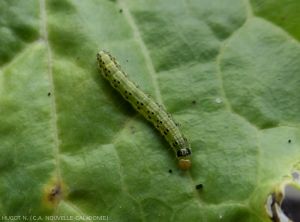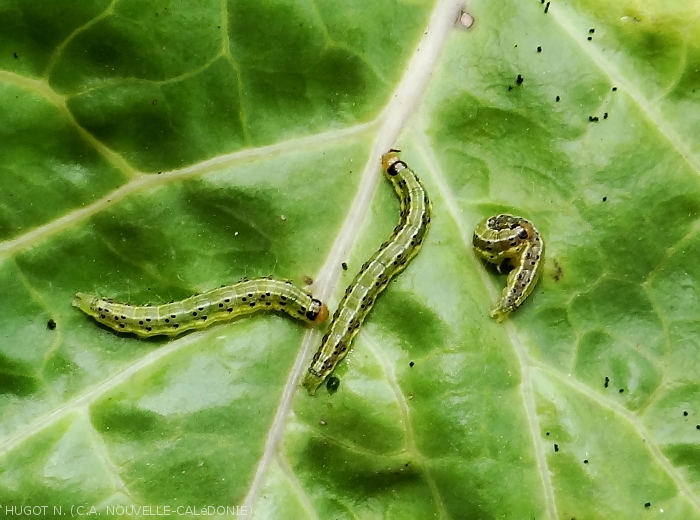Crocidolomia binotalis (pavonana),
Hellula undalis, H. phidilealis
Cabbage moths
General
- Insects belonging to the Pyraloidae superfamily and to the Crambidae family. The species encountered in the French overseas departments and territories are:
- Hellula undalis very widespread in the world: found as well in Europe as in Africa, Asia, as well as in certain islands of the Pacific.
- Crocidolomia binotalis affects a large part of the inter-tropical zone (Africa, Asia, Australia and some islands of the Pacific).
- Hellula phidilealis : its presence remains for the moment confined to the inter-tropical zone of the American continent and certain islands of the Caribbean Sea. It is however absent from Guadeloupe and Martinique.
- Adults, moth-type moths attack many plants of the Brassicaceae family.
- Observed in the open field as well as under shelter (soilless cultivation of Chinese cabbage)
- Sensitive botanical family (s) *
* These moths attack many species of plants of the Brassicaceae family including: cabbage, Brussels sprouts, cauliflower, broccoli, kale, turnip, radish, and mustard. Note that C. binotalis can also feed on watercress and thyme.
- Affected production areas :
| |
Reunion island |
Guyana |
| Crocidolomia binotalis |
|
|
| Hellula undalis |
|
|
| Hellula phidilealis |
|
|
| |
New Caledonia |
French Polynesia |
| Crocidolomia binotalis |
|
|
| Hellula undalis |
|
|
Symptoms, damage
- Symptoms :
- Leaves especially, but also inflorescences, young leaves of the heart (especially C. binotalis ) grazed superficially by the caterpillars.
- perforations of the stems and ribs of the leaves (especially H. undalis ).
- Signs : Presence of caterpillars on plants, and in the crop (figures).
Biology
- Development cycle : Eggs are laid singly in Hellula spp. or in in bundles C. binotalis .
- The larvae develop on the foliage. Various signs can be used to distinguish species:
- caterpillars C. binotalis are grouped and concentrated in the heart of the plant, rather green, bearing 3 longitudinal white lines on the back and 2 white lines and black dots on the lateral part of the body.
- the caterpillars of Hellula spp. are whitish to beige with 2 light brown longitudinal lines on each side of the body.
- Some hairs are present on the caterpillars of Crocidolomia , while those of Hellula are lacking. The end of the body of the first tracks are fork-shaped.
- Pupation taking place a few centimeters below the surface of the balance ( C. binotalis ), in a cocoon on plants ( Hellula spp.).
- The adults are small butterflies (about 2 cm) of gray-beige color. When posed, they are longer than they are wide and have a triangular hang-glider shape.
Protection
- Produce the plants in an nursery insect-proof , insect-proof at best under nets to avoid early attacks on the plants as well as egg laying.
- Avoid repeating Brassica crops on the same plot.
- Check the sanitary quality of the plants before and during their introduction into the crop or shelter.
- Place in the culture sticky plates to detect the presence of adult moths.
- Install type P17 non-woven netting, insect-proof in particular in the presence of small tunnel planting areas.
- Use biopesticides based on Bacillus thuringiensis, effective if applied as soon as the young stages of caterpillars appear.
- interventions Phytosanitary against the moths of the genus Hellula must be carried out before the caterpillars enter the plant, otherwise they will no longer be accessible.

Figure 1

Figure 2

Figure 3






